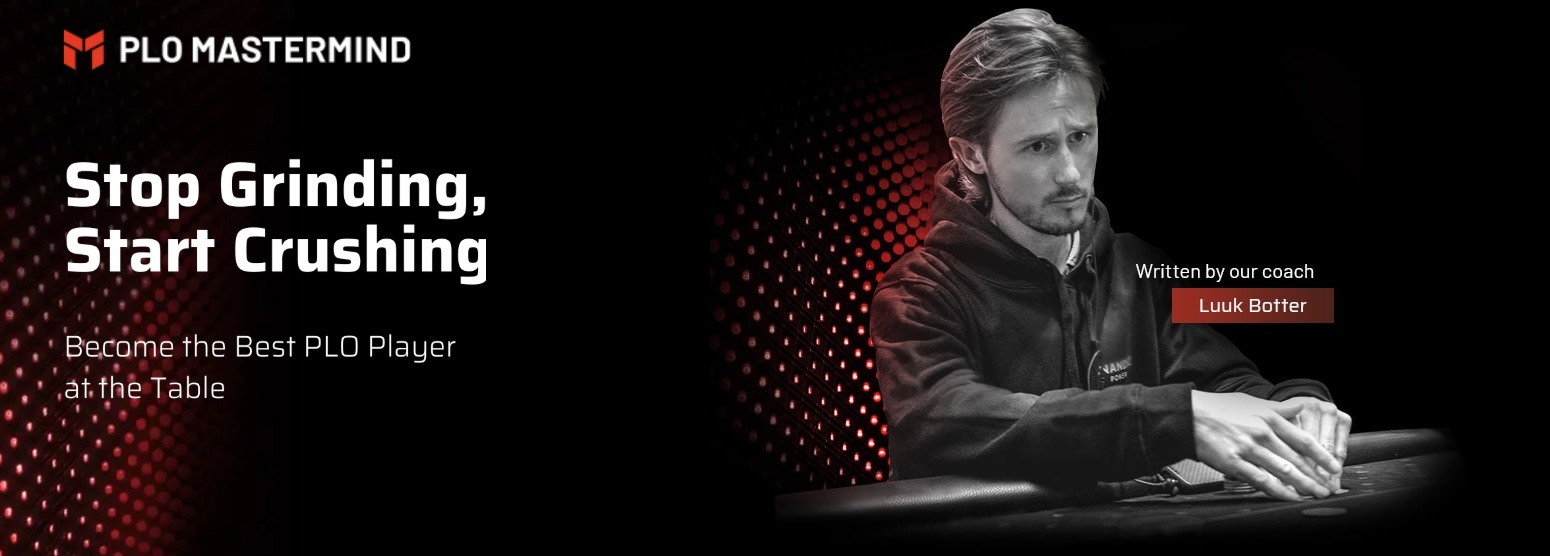
Check out how Luuk Botter, one of the head coaches at the Omaha Poker training site PLO Mastermind, is breaking down the range vs. range thinking concept:
I was in a deep study session, looking at a hand that felt incredibly standard. It was a single-raised pot, I was the preflop raiser from UTG, and the Big Blind had called.
After barreling the flop and turn in position, the board ran out as follows:

On the river, as my mouse hovered over the bet button for the third time, a question popped into my head:
“If I had total air here, would I still be betting? What are my bluffs?”
For years, I viewed bluffing as something optional, a creative play you make when the conditions are perfect. But the more I learned about poker, the more I realized this mindset is a major flaw.
I needed to switch my thinking from “bluffing is optional” to “bluffing is mandatory and important in every single spot.”
The simple reason is that if my opponents don’t perceive that I have enough bluffs, my value hands won’t win enough money. It is technically impossible for me to maximize the EV of the top of my range without understanding how to play the bottom of my range.
If you look at sims, the only reason we bluff is to make sure we get paid off when we have it. It’s that simple.
Many of us, including myself, fall into a mental trap: we want to get paid off when we have a monster, but we also want our opponents to fold every single time we’re bluffing. Unfortunately, you can’t have both.
I’ve started to think about it like this: Every bluff I make is an investment. The return on my investment is the value I have in a future hand.
Let’s go back to our first example board above. On this runout, it’s easy to find your value bets. You have plenty of sets and two pairs in your UTG range that are happy to bet three times. But what about your bluffs? Are you capable of finding enough bluffs to balance out all that value, so that your opponent is forced to pay you off?
Take a moment. What hands are you triple-barreling as a bluff here?
It’s tricky. In PLO, the solver finds bluffs with hands you might not expect. Would you triple barrel off with 5522? Or 7654? What about some of your other low rundowns that you decided to c-bet? These are the exact hands that are needed to actually have enough bluffs in this spot and put your opponent’s bluff-catchers in an impossibly tough situation.
If you do so, you end up putting a hand like QT99 into indifference on the river. Pretty nice right?
Now, let’s look at another example:
We are in a 3-bet pot as the caller on the Button. The SB checks, we bet 1/3 pot, and the SB calls. On the turn the SB checks again and it’s up to us.

This is a spot where we have a nut and equity advantage. Finding our value bets here is easy, we have a ton of flushes, sets, and straights. But what about our bluffs? The solver shows that we should be betting with 69% of our one-pair hands here, hands that are clearly not betting for value.
Even more surprising, the vast majority of these bluffs are hands that don’t hold the A♠ or K♠ blocker. This one sub-category of hands makes up almost 25% of our entire range, and we are betting with it over 60% of the time. These are not easy bluffs to find, and it takes real work to train yourself to pull the trigger with them.
Basically, you need to try really hard to find all these bluffs! Finding value is A LOT easier!

Key Takeaways on Bluffing
- Bluffing is Mandatory, Not Optional: Shift your mindset. You are not looking for a “good spot to bluff”; you are looking for the correct bluffs to balance the value hands you are already betting in every single spot.
- Every Bluff is an Investment: Stop thinking about whether an individual bluff gets through. Think of each bluff as an investment that increases the likelihood of your value bets getting paid off in the future.
- Finding Value is Easy, Finding Bluffs is Hard: Your opponents will often have an easy time figuring out your value range. The real challenge, and where your edge comes from, is in constructing a bluffing range that is difficult to play against. This skill often separates breakeven players from winning ones, and it requires dedicated work away from the tables.
Thanks for reading,
Let’s Crush It
Luuk
As a PLO enthusiast with nearly 12 years of experience, I’m passionate about breaking down the complexities of Pot Limit Omaha, helping you sharpen your strategy and grow your bankroll – no matter your current level. I also share exclusive bonus and rakeback deals, along with discounts on poker courses and tools, so you can get an extra edge. When I’m not writing, you’ll usually find me online, playing PLO cash games and turbo MTTs.

